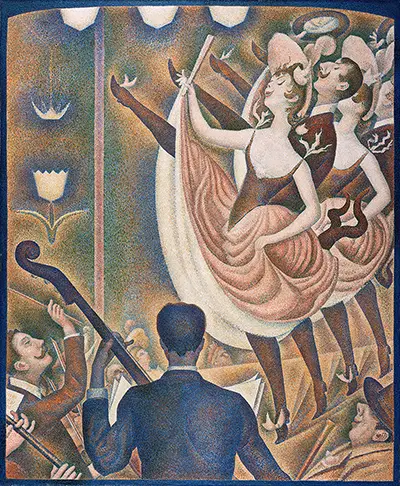Le Chahut is Georges Seurat's Neo-Impressionist canvas dated 1889 to 1890. It was first on show at the 1890 Salon de la Society of Individual Artists in Paris, where other pieces were eclipsed. The primary goal of art critics and the symbolist critics frequently debated topic was the Chahut.
Le Chahut is a canvas oil painting. Seurat used a divisional theme, with dotted colours. The work is dominated by a colour scheme that tends to the red end of the spectrum, of earth tones drawn on a palette of blues, browns, warm greys, and tans. It is interwoven with the primary colours of yellow and red and the six main colours. Additionally, 18 mixtures on his palette are combined before being painted on the canvas. A shallow arch on the upper side culminates in a darker blue margin drawn along the canvas's edge.
The Inspiration
Women and men perform the chahut or cancan with passion, a provocative dance where the women pick up their skirts and wave their knees in the air.
Despite its robust theme, Le Chahut is not a brief nightlife scene in Paris, but a carefully considered painting. The effect of light and colour fascinates Seurat, and he finds a way to systematically make this effect. He has caught the flamboyant dance in a strict scheme of various minute points of lines, colour, and paint variations.
In warm colours and electric light, the hall is bathed. More like archetypes than men of flesh and blood do the dancers seem. They are travelling in the same rhythm. In all its stripes and gestures, the men's moustaches, dancers' thighs, the corners of ladies' mouths or eyes, the conductor's hand, the bass collar, the flowers in the distance, are all led up to the arousal of dancing and music.
The Technique
Seurat was obsessed, as did the Impressionists, with light and colour. Yet, he was so passionate about impressionist painting. In answer, he has created a painting technique that reveals none of the painter's personality. He used just seven shades and put them on so close to one another in tiny dabs that the eye fuses them in small tints and shapes.
This neo-impressionist way of painting is called "pointillism," which means "dab," from the French term "point." Seurat was the inventor of this technology and collaborated with other artists to propagate it directly. After a Seurat visit, Vincent van Gogh fell under the effect of his art of painting and colour preference.





